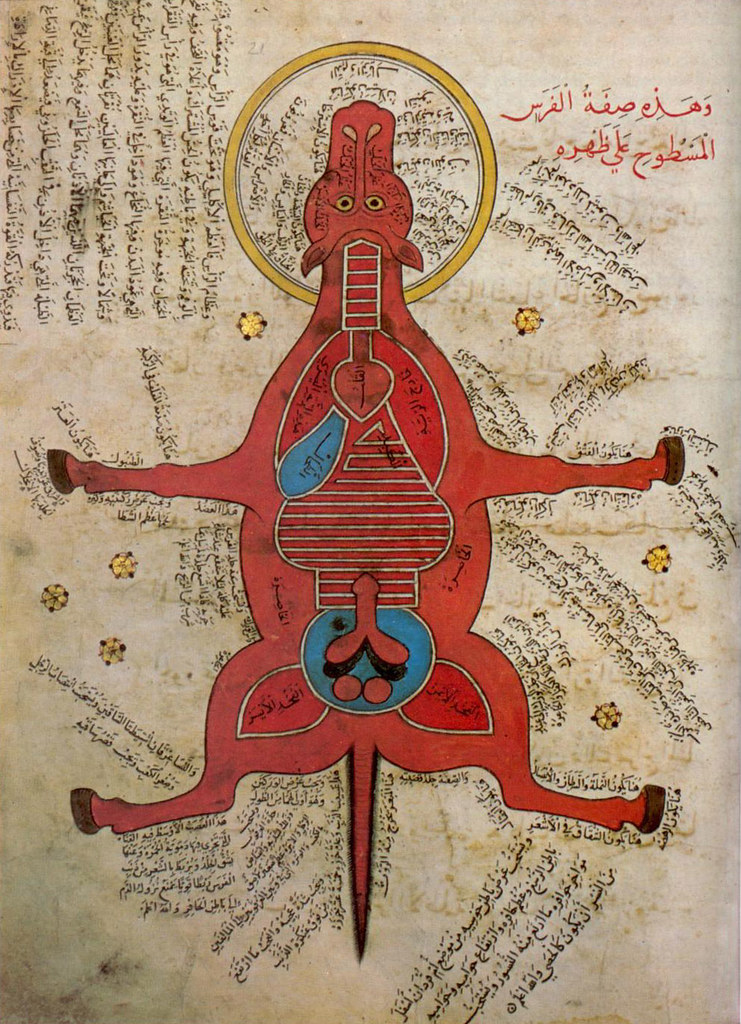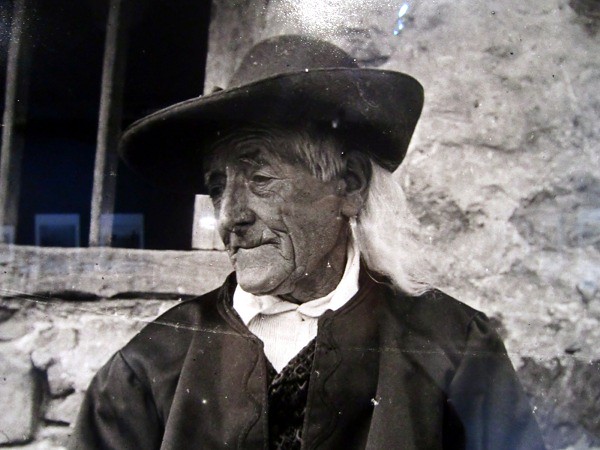Following readings, comments and bar conversations about what I have been calling "my problems with the canon of science fiction."

Anatomy of a horse in Egypt, the fifteenth century (Library of the University of Istanbul)
colonization of the past: the palms
"When it grows on the edge of water, [palm] is called k̄ari'a , the palm tree that gives dates early still very young is called mahtajina , and muhajjna female tree is first fertilized by pollen from the male date palm. If bears fruit in alternate years Sanha called ', if the dates fall, still green when they are starting to mature ( Busr ), the tree is a Khadira , if the lower trunk has frayed and fringed the base of the branches ( karab ) loses the bark, the tree is a ṣunb̄ur (old palm tree that gives little fruit), if you lean and you have to prop it up, the palm is rujabiyya , if grown in isolation from other palm takes its name from 'awana . When the palm is still a mere outbreak called Fasil or wadiyya (young shoot of palm). When you log ( jidh ') has completed its development and bears fruit is jabbar, and when called high raqla or ' Aydan . "
This description comes of "Fiqh al-Lugha, a tenth century Arabic text that appears referenced in the General History of Science" published René Taton when occupied the post of director of the National Research Center Science of Paris in the sixties. The statement belongs to the chapter on medieval science, in particular the invaluable role played by Arab intellectuals in the dissemination of Greek texts with the help of some intermediate Syriac terms translated into Latin. These translations, enriched (and interpreted from) the exuberance of Arabic, will later be recovered by the Renaissance thinkers to become part of the pillars of what we now know as modern science. A job that, according to Taton, was not strictly philological, but that "often the occasion also gave a very favorable research development of the scientific spirit: the identification and verification of concepts. "

"Kitab al-Nabat" (Book of Plants) Dīnawarī Abu Hanifa (d.895 AD)
When I bought the work of Taton (for € 7 in a flea market in an edition of 18 volumes eighties hardcover, quite ugly) someone asked me what the point of reading a history of science written more than forty years. The question surprised me because the answer seems obvious. History (History) is a discipline concerned with telling what happened in the past but the way we tell ourselves what happened. The stories, myths, foundation-about how we got to be the most scientifically advanced civilization in the history of mankind are the same today as forty years ago: Greek philosophy, Alexandrian medicine, theology, medieval, Renaissance delivery, the Enlightenment rationalism, the discovery of magnetism and the invention of electricity, the theory of evolution, X-rays, psychoanalysis (Is psychoanalysis?), the theory of relativity, the atomic bomb, cybernetics, genetics, computing. All history is historiography. Addition content, it is interesting to look at the way they are presented: everything from the chronological organization and management of the chapters to the records of language, references and illustrations, tells of how we talk, how to interpret the past and we project into the future. All history is narrative fiction production concatenated.
The decolonization of the future: the Mahdi
Another text: a short essay on postcolonial theory teacher Salman Sayyid, published in the collection "Stitch and Split. Selves and Territories in science-fiction " (edited by Constant vzw Belgian group in 2004). In it the author proposes a peculiar view of the political mythology contained in a classic of popular science fiction, Frank Herbert's novel, "Dune" : when Paul Atreides, hailed by the natives of the desert planet Arrakis proclaims "You say I am the Mahdi, I say I'm his duke."
Dune is a work influenced by the aesthetics of Orientalism . According to this aesthetic, which like all aesthetic includes a policy that one side is the Western world, known, civilized, one from which everything else revolves, and secondly, the universe and more specifically Islamic East: unknown, exotic and hostile and whose existence is defined in relation to and in opposition to the former, which is the model reference. This binary structure preserves the relationship ethnocentric convention: There is There is the West and the Rest . In this sense, the universe of Dune, and the idea of \u200b\u200blooking statements contained in it, does not propose anything new, including Islam, but as static inheritance and subordinate, "as a Renaissance world marked by a legacy of which denies Islamized."

However, the dialectic between the figure of the Mahdi and the Duke introduced a nuance, that Syyid interpreted as an opportunity to break with the established order. The mahdi (دي "he to whom divine guidance") is a category of Islamic political system that breaks all the hierarchies that do not have their origin in virtue. The Duke, by contrast, denotes a kind of political authority of the feudal organization, based on the display of electronically transmitted hereditary privileges regardless of the intrinsic values, ethics or morals of the person you are granted. While Duke is worldly or earthly position, the nature of the Mahdi is not only divine but the messianic . For Sayyid, l a reference to the messianic, as transcendent as its own category (which goes beyond ), brings in the Islamic world in history and therefore in the future as it stands before to participate actively in the transformation of the world but also, more importantly, the authorized narratives of these transformations. The Mahdi arises and compromise figure that makes possible the return of history to a people historically deprived of it. The Herbert's Dune contain then a subversion of the political drama contained in the popular science fiction reverse the colonial view of history.
recolonization of this: the Duke
Atreides But, as we have said, he rejects the title of Mahdi, eliminating the possibility of historical emancipation of the Arab people and returning the world of Dune to the logic of the colonial or rather, of re-colonized. Islam is relegated to the Orientalist narrative cycle in which only one can imagine a horizon of political transformation in the context of records identified as Western. "It Interestingly, "continues Sayyid," in the vocabulary of the "war on terror," one of the parties referred to the conflict in cosmological terms, civilization, freedom, etc.., while the other-which often there is criticism that is solely motivated by cosmological-talk in concrete political terms, as the end of Israeli occupation of the West's support of Muslim tyrants, etc.. "
In your opinion, what the Atreides gesture suggests, it always is better to be a second-level sovereign West to be a non-western figure, even though this may have significance in the future of the universe. [...] The cost of favoring the Duke on the Mahdi means, of course, prefer the status quo to the possibility of a brighter future, but in the era of neoliberal consensus, the lack of willingness of the producers of Dune to pay that price should not surprise us. The consequence of all this is that popular science fiction continues to delay the decolonization of the future. "

